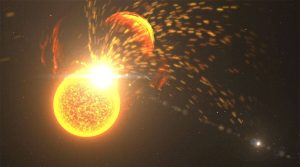The Sun, our nearest star, is a dynamic and captivating celestial body. It periodically unleashes intense bursts of energy known as solar flares, which have a profound impact on our solar system and Earth. In this blog post, we will delve into the mesmerizing world of solar flares, exploring their causes, characteristics, and their significance for our planet.
I. Understanding Solar Flares:
- What are Solar Flares? Solar flares are powerful eruptions of electromagnetic radiation and charged particles from the Sun’s surface. They result from complex interactions within the Sun’s magnetic field and plasma.
- The Sun’s Structure: To understand solar flares, we must first explore the Sun’s internal structure, including the core, radiative zone, and convective zone. This knowledge helps us grasp the processes that drive these explosive events.
II. Causes and Triggers:
- Magnetic Fields: Solar flares are primarily driven by the Sun’s intricate magnetic fields. Magnetic interactions, such as magnetic reconnection, release enormous amounts of energy, resulting in the eruption of material and radiation.
- Sunspots: Sunspots, dark regions on the Sun’s surface with intense magnetic activity, are often associated with solar flares. These localized magnetic disturbances provide the conditions necessary for flare formation.
III. Characteristics of Solar Flares:
- Energy Release: Solar flares unleash staggering amounts of energy, equivalent to millions of atomic bombs. The energy is emitted across the electromagnetic spectrum, from radio waves to X-rays and gamma rays.
- Classification: Solar flares are classified based on their peak X-ray flux. The classification system, known as the GOES scale, ranges from A-class (weakest) to X-class (most powerful) flares.
- Duration and Evolution: Solar flares can last from minutes to hours, with a distinct evolution characterized by an initial impulsive phase followed by a gradual decay.
IV. Effects and Impacts:
- Space Weather: Solar flares significantly influence space weather conditions in the vicinity of Earth. They can cause disturbances in the ionosphere, disrupt radio communications, and affect satellite operations.
- Aurora Borealis and Aurora Australis: Powerful solar flares can trigger stunning displays of the Northern and Southern Lights. These colorful phenomena occur when charged particles from the Sun interact with Earth’s magnetic field.
- Power Grids and Infrastructure: Intense solar flares pose a threat to power grids and critical infrastructure. The release of charged particles can induce powerful geomagnetic storms that can disrupt electrical systems on Earth.
V. Scientific Research and Observations:
- Solar Observatories: Dedicated space-based observatories, such as NASA’s Solar Dynamics Observatory (SDO) and the ESA/NASA Solar and Heliospheric Observatory (SOHO), provide valuable insights into the behavior and dynamics of solar flares.
- Studying Solar Flares: Scientists employ various instruments and techniques to study solar flares, including X-ray telescopes, radio telescopes, and spectrometers. These observations enhance our understanding of the underlying physical processes.
VI. Future Directions:
- Solar Flare Prediction: Advancements in solar flare modeling and forecasting techniques aim to improve our ability to predict these events. This knowledge can help mitigate the potential impacts of solar flares on Earth.
- Solar Probe Missions: Upcoming missions, such as NASA’s Parker Solar Probe and ESA’s Solar Orbiter, will provide unprecedented insights into the Sun’s atmosphere and the mechanisms driving solar flares.
Conclusion: Solar flares, spectacular displays of solar power and magnetism, continue to captivate scientists and enthusiasts alike. As we deepen our understanding of these explosive events, we gain valuable insights into the dynamics of our Sun and the intricate relationship between our star and our planet. Exploring the mysteries of solar flares paves the way for scientific advancements and ensures our preparedness for the impacts of space weather.




















Add Comment